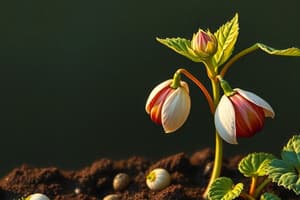Podcast
Questions and Answers
Growth in organisms refers to an irreversible increase in both size and mass.
Growth in organisms refers to an irreversible increase in both size and mass.
True (A)
Cell division leads to a decrease in the overall number of cells in an organism.
Cell division leads to a decrease in the overall number of cells in an organism.
False (B)
Development involves the specialization of cells into different types, each with specific functions.
Development involves the specialization of cells into different types, each with specific functions.
True (A)
The plumule develops into the mature root system of a plant.
The plumule develops into the mature root system of a plant.
Cotyledons primarily function in structural support, providing rigidity to the developing stem.
Cotyledons primarily function in structural support, providing rigidity to the developing stem.
During seed germination, water absorption via the micropyle helps to break the seed coat.
During seed germination, water absorption via the micropyle helps to break the seed coat.
Insoluble food reserves in cotyledons are directly used by the embryo without any conversion.
Insoluble food reserves in cotyledons are directly used by the embryo without any conversion.
Soluble food substances are transported to the plumule and radicle to support their growth and development.
Soluble food substances are transported to the plumule and radicle to support their growth and development.
Root hairs develop on the plumule to maximize water and mineral absorption efficiency.
Root hairs develop on the plumule to maximize water and mineral absorption efficiency.
The hypocotyl, in its hooked form, aids in pulling the cotyledons above the soil surface.
The hypocotyl, in its hooked form, aids in pulling the cotyledons above the soil surface.
After straightening, the hypocotyl remains white and underground throughout the entire plant lifecycle.
After straightening, the hypocotyl remains white and underground throughout the entire plant lifecycle.
During the first 3 days of seed germination, starch levels decrease as they are converted into sugars.
During the first 3 days of seed germination, starch levels decrease as they are converted into sugars.
From days 3 to 5 of seed germination, the rate of starch conversion into sugar is less than sugar consumption.
From days 3 to 5 of seed germination, the rate of starch conversion into sugar is less than sugar consumption.
From day 5 to 7 of seed germination, total carbohydrates decrease because they're used as an energy source.
From day 5 to 7 of seed germination, total carbohydrates decrease because they're used as an energy source.
Water activates amylase in seeds to soften the plumule and radicle for germination.
Water activates amylase in seeds to soften the plumule and radicle for germination.
The three essential conditions for seed germination are water, suitable temperature, and sunlight.
The three essential conditions for seed germination are water, suitable temperature, and sunlight.
Growth and development in plants primarily occur in the meristems.
Growth and development in plants primarily occur in the meristems.
Apical meristems contribute to secondary growth, increasing the thickness of the plant.
Apical meristems contribute to secondary growth, increasing the thickness of the plant.
The lateral meristem, also known as cambium, is found within the xylem and pholem of stems and roots.
The lateral meristem, also known as cambium, is found within the xylem and pholem of stems and roots.
The root cap protects the apical meristem from friction and mechanical damage as the root grows through the soil.
The root cap protects the apical meristem from friction and mechanical damage as the root grows through the soil.
Flashcards
Growth
Growth
The irreversible increase in the size and weight of an organism.
Development
Development
The specialization of cells into different cell types to perform different functions, leading to increased organism complexity.
Seed coat
Seed coat
Protects the embryo within the seed.
Plumule
Plumule
Signup and view all the flashcards
Radicle
Radicle
Signup and view all the flashcards
Cotyledons
Cotyledons
Signup and view all the flashcards
Micropyle
Micropyle
Signup and view all the flashcards
Role of water in seed germination
Role of water in seed germination
Signup and view all the flashcards
Enzyme action in germination
Enzyme action in germination
Signup and view all the flashcards
Root hairs Function
Root hairs Function
Signup and view all the flashcards
Hypocotyl Role
Hypocotyl Role
Signup and view all the flashcards
Apical meristem
Apical meristem
Signup and view all the flashcards
Lateral meristem
Lateral meristem
Signup and view all the flashcards
Xylem and Phloem
Xylem and Phloem
Signup and view all the flashcards
Region of Differentiation
Region of Differentiation
Signup and view all the flashcards
Region of Elongation
Region of Elongation
Signup and view all the flashcards
Region of Cell Division
Region of Cell Division
Signup and view all the flashcards
Root cap
Root cap
Signup and view all the flashcards
Study Notes
- Growth is the irreversible increase in an organism's size and weight.
Types of Growth
- Cell division increases the number of cells.
- Cell enlargement increases the size of cells.
- Development is the specialisation of cells into different types for different functions.
- Development increases the organism's complexity.
Seed Structure
- The seed coat protects the embryo.
- The plumule develops into the shoot.
- The radicle develops into the root.
- Cotyledons act as food reserves and release energy through respiration.
Seed Germination
- The seed absorbs water through the micropyle, causing the seed coat to break.
- Insoluble food in cotyledons converts to a soluble form via enzymes.
- Soluble food transports to the plumule and radicle to facilitate growth and development.
- Root hairs develop on the radicle, increasing surface area for water and mineral absorption.
- The hooked hypocotyl brings the cotyledon above the soil.
- The hypocotyl straightens, cotyledons turn green, and photosynthesis occurs.
- Young leaves develop, after which the cotyledons fall off.
Changes in Dry Mass During Seed Germination (Days 0-3)
- Starch levels decrease as starch is digested into sugar by amylase.
- Sugar levels increase because the conversion of starch into sugar exceeds sugar usage.
- Total carbohydrate amounts decrease.
Changes in Dry Mass During Seed Germination (Days 3-5)
- Sugar levels remain constant because the conversion rate of starch to sugar equals the rate of sugar usage.
- Starch decreases.
- Total carbohydrate amounts decrease.
Changes in Dry Mass During Seed Germination (Days 5-7)
- All levels increase as photosynthesis can take place.
Water Use in Germination
- Water softens the seed coat for rupture by radicle and plumule growth.
- Water activates the enzymes in the seeds for germination.
- Water causes the seed to swell, breaking the seed coat.
Germination Conditions
- Water is required.
- A suitable temperature is required.
- Oxygen is required.
Growth and Development Locations
- Growth and development occur in the meristems.
Apical Meristem
- Found at the tips of roots and shoots.
- Increases the plant's length, known as primary growth.
Lateral Meristem
- Located between the xylem and phloem of stems and roots (cambium).
- Increases the plant's thickness, known as secondary growth.
- Secondary xylem and phloem differentiate.
Regions of the Growing Root
- The region of differentiation specialises to perform specific functions.
- The region of elongation increases cell size by water intake.
- The region of cell division produces new cells via mitotic cell division.
- The root cap protects the apical meristem against friction.
Studying That Suits You
Use AI to generate personalized quizzes and flashcards to suit your learning preferences.




